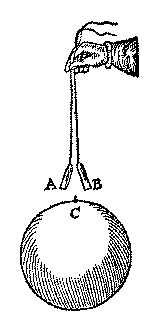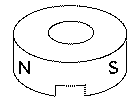|
Review #1 Review #2 Earth's Core Tobacco Smoking & Moving Continents |

Given two magnets, Gilbert knew that magnetic poles can attract or repel, depending on polarity. In addition, however, ordinary iron is always attracted to a magnet--even soft iron, which loses all its magnetism again when it is removed again. Gilbert guessed, correctly, that near a permanent magnet such iron became a temporary magnet, of a polarity suitable for attraction. That is, the end of an iron bar stuck to an S pole of a magnet (south-seeking pole) temporarily becomes an N-pole. Because magnetic poles always come in matched pairs, the other end of the bar temporarily becomes an S-pole, and can in its turn attract more iron. You see this if you dip (say) a horseshoe magnet into a cup with iron pins. As expected. many pins will stick to the poles, but in addition, some more pins will stick to those pins. Yet when the pins are pulled loose, they all are seen to be non-magnetic again. Gilbert confirmed his guess of temporary ("induced") magnetism by an original experiment (see drawing). Using strings, he hung two parallel iron bars above the pole of a terrella, and noted that they repelled each other. Under the influence of the terrella, each became a temporary magnet with the same polarities, and the temporary poles of each bar repelled those of the other one. (By the way--can you find the same experiment portrayed on the front cover of "De Magnete"?) |
 You will need (1) a small button magnet (drawing), of the type made of steel and used to pin messages to metal partitions in offices (not a flat refrigerator magnet, too weak), and (2) two thin finishing nails, the long kind with small heads, about 5 cm (2") long. If these are not available, find two thin long nails and cut or saw off their heads, leaving equal lengths.
You will need (1) a small button magnet (drawing), of the type made of steel and used to pin messages to metal partitions in offices (not a flat refrigerator magnet, too weak), and (2) two thin finishing nails, the long kind with small heads, about 5 cm (2") long. If these are not available, find two thin long nails and cut or saw off their heads, leaving equal lengths.
 Place the magnet on a flat table or the surface of a projector, as drawn, with the attracting pole-ends downwards (the figure is drawn in the plane of the table or projector). Stick the point of one nail to the side of one pole of the magnet, perpendicular to it. Restrain the nail with your fingers from moving off-perpendicular, as it tends to do when it tries to increase its surface contact with the magnet.
Place the magnet on a flat table or the surface of a projector, as drawn, with the attracting pole-ends downwards (the figure is drawn in the plane of the table or projector). Stick the point of one nail to the side of one pole of the magnet, perpendicular to it. Restrain the nail with your fingers from moving off-perpendicular, as it tends to do when it tries to increase its surface contact with the magnet.